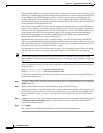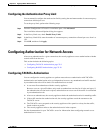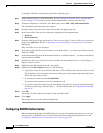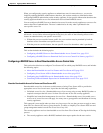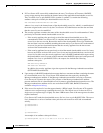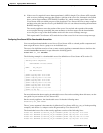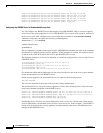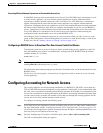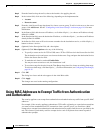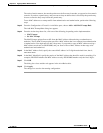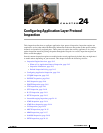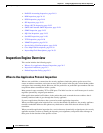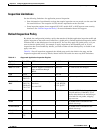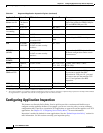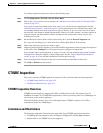
23-16
Cisco ASDM User Guide
OL-16647-01
Chapter 23 Applying AAA for Network Access
Using MAC Addresses to Exempt Traffic from Authentication and Authorization
Step 3 From the Interface drop-down list, choose the interface for applying the rule.
Step 4 In the Action field, click one of the following, depending on the implementation:
• Account
• Do not Account.
Step 5 From the AAA Server Group drop-down list, choose a server group. To add a AAA server to the server
group, click Add Server. See the “Configuring AAA Server Groups” section on page 14-9 for more
information.
Step 6 In the Source field, add the source IP address, or click the ellipsis (...) to choose an IP address already
defined in ASDM.
Step 7 In the Destination field, enter the destination IP address, or click the ellipsis (...) to choose an IP address
already defined in ASDM.
Step 8 In the Service field, enter an IP service name or number for the destination service, or click ellipsis (...)
button to choose a service.
Step 9 (Optional) In the Description field, add a description.
Step 10 (Optional) Click More Options to do any of the following:
• To specify a source service for TCP or UDP, enter a TCP or UDP service in the Source Service field.
The destination service and source service must be the same. Copy and paste the destination Service
field to the Source Service field.
• To make the rule inactive, uncheck Enable Rule.
You may not want to remove a rule, but instead turn it off.
• To set a time range for the rule, from the Time Range drop-down list, choose an existing time range.
To add a new time range, click the ellipsis (...). For more information, see Configuring Time Ranges,
page 19-15.
Step 11 Click OK.
The dialog box closes and the rule appears in the AAA Rules table.
Step 12 Click Apply.
The changes are saved to the running configuration.
Using MAC Addresses to Exempt Traffic from Authentication
and Authorization
The security appliance can exempt from authentication and authorization any traffic from specific MAC
addresses.
For example, if the security appliance authenticates TCP traffic originating on a particular network but
you want to allow unauthenticated TCP connections from a specific server, you would use a MAC
exempt rule to exempt from authentication and authorization any traffic from the server specified by the
rule. This feature is particularly useful to exempt devices such as IP phones that cannot respond to
authentication prompts.



